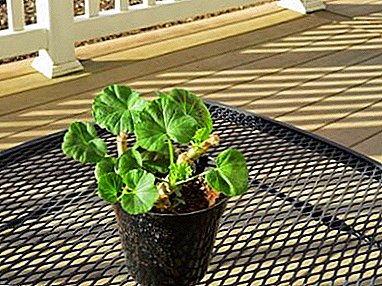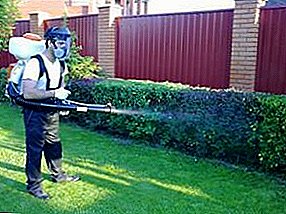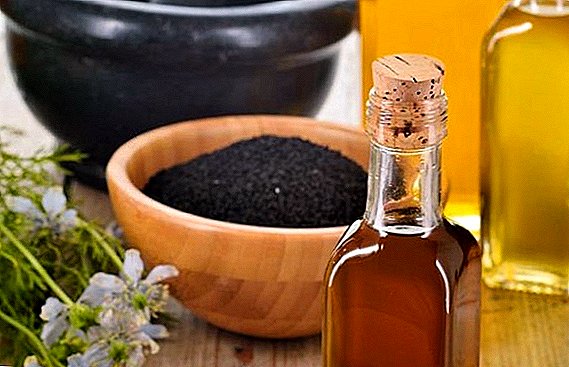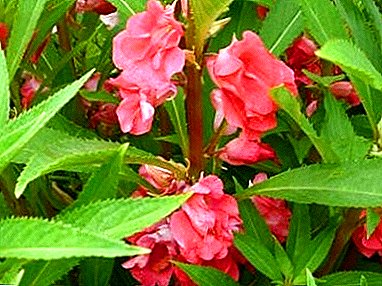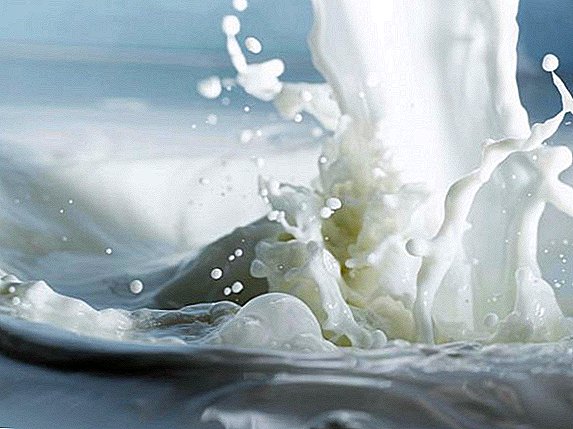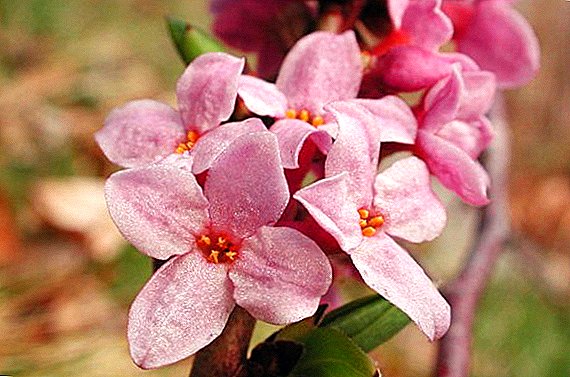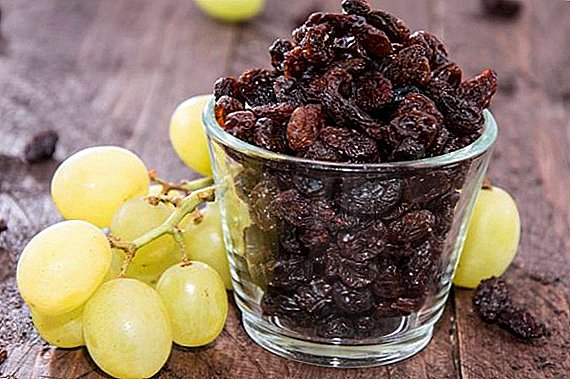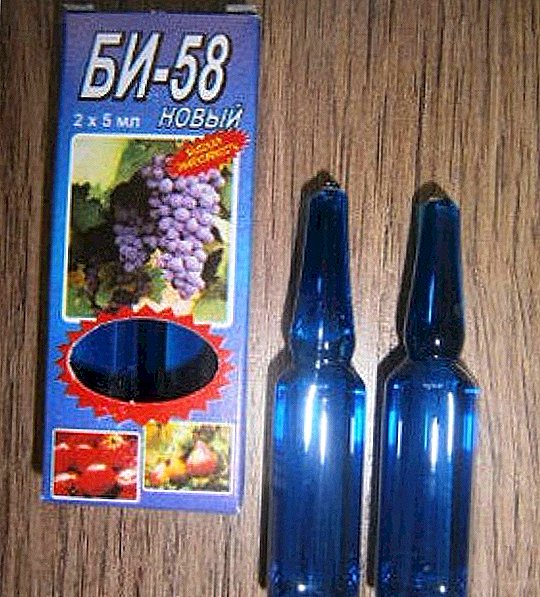 "BI-58" is a convenient and reliable insecticide that qualitatively fights insect pests. This drug is used in agriculture and on an industrial scale, as well as in the household. Let's take a closer look at how to use the "BI-58" at home and what precautions are needed.
"BI-58" is a convenient and reliable insecticide that qualitatively fights insect pests. This drug is used in agriculture and on an industrial scale, as well as in the household. Let's take a closer look at how to use the "BI-58" at home and what precautions are needed.
Description, release form, appointment
The newest insecticide "BI-58" is a reliable drug in the fight against pests that destroy plants.
Did you know? The main substance in the composition is an ester of phosphoric acid.
 This tool is used both on an industrial scale and in individual agriculture. "BI-58" has a very wide application and high efficiency, namely, it is used to combat insect pests, caterpillars, ticks on many agricultural crops.
This tool is used both on an industrial scale and in individual agriculture. "BI-58" has a very wide application and high efficiency, namely, it is used to combat insect pests, caterpillars, ticks on many agricultural crops.The tool has the form of an emulsion concentrate, is sold in containers of various capacities for possible use at various scales.
The mechanism of action of the insecticide
The preparation "BI-58" has a systemic and contact effect, which allows it to influence a large number of different pests. In contact with the insect, the insecticide instantly penetrates through its protective covers.
The systemic effect is that the green parts of the plants absorb it into themselves. The tool is evenly distributed throughout the plant and acts on the insect after it absorbs the leaf, the drug poisons the pest through the intestinal system. "BI-58" is evenly distributed throughout the plant, which provides effective protection against pests in the newly growing parts.
Insecticides also have systemic and contact effects: Konfidor, Komandor, Nurell D, Calypso, Aktara.
Insecticide is classified as highly toxic to ticks and insects, it is also very dangerous for bees. It is not recommended to use this poison near water bodies, since it can pose a threat to fish. At the same time, the drug is slightly toxic to warm-blooded animals.
Insecticide can slightly damage the human skin, but when in contact with mucous membranes is a threat, therefore, it is recommended to use additional means for protection.
When and how to use the "BI-58": instructions
This insecticide should not be used to treat plants immediately after frost, as this may decrease its effectiveness by an order of magnitude.
Did you know? Agronomists say that for "BI-58" ideal application occurs at a temperature for spraying + 12 ... +35 ° C.It is necessary to process cultures during the period of active vegetation and insect concentration. It should not be forgotten that, depending on the type of plant, it may be necessary to re-process the preparation.
Use the solution immediately after preparation. Prepare the product directly in the sprayer tank, stirring thoroughly during preparation and spraying. Also, the effectiveness of the drug decreases if it is dissolved in water with impurities of silt or clay.

It is necessary to pay special attention to the fact that when using "BI-58" with hard water, the composition of the drug may change. In order to properly use the "BI-58", you need to study in detail the instructions of the drug, which is given below. You should also take into account the concentration of "BI-58" in order to know how to properly dilute the drug with water and protect the plants.
In the garden
When spraying vegetable crops, the recommended “BI-58” consumption rate is 0.5-0.9 kg / ha. Insecticide effectively kills mites, aphids, thrips, bedbugs. It is necessary to spray vegetables during the growing season with the consumption of the prepared working solution of 200-400 liters per hectare. It is necessary to process twice, and it is necessary to leave for work in a kitchen garden in 10 days. Potatoes are processed in a similar way, but already with a concentration of 2 kg per hectare.
For garden crops
For garden crops and fruit plants, this drug is used with high dosage. The manufacturer recommends such consumption rates for garden crops - from 1.6 to 2.5 kg of concentrate "BI-58" for 1 hectare. The amount of liquid concentrate for solution preparation increases proportionally.
For apples and pears in the fight against pests such as scab, moth, tick, leafworm, aphid, hedgehog, moth, moth, gnawing caterpillar, beetles, the application rate of the drug concentrate is 0.8-1.9 kg per 1 hectare. Spray need before and after flowering. The prepared working solution is spent on 1 hectare - from 1000 to 1500 liters. The number of recommended treatments - 2.
When processing apple trees from] an apple flower beetle, the rate of application of the preparation concentrate for 1 hectare is 1.5 kg. Spray need during the flowering of apple trees. The consumption of the prepared working solution is 800-1000 liters of ready-made solution per 1 hectare of garden. The number of treatments - 1.

When processing grapes from tick, mealybug, moth, the recommended rate of application of concentrate 1.2-2.8 kg for 1 hectare. Spraying should be done during the growing season. The number of spraying - 2 times. The consumption of the prepared working solution is from 600 to 1000 liters per 1 hectare of vineyard.
When processing currants from leafworms, aphids and gall midges, the rate of application of the concentrate is from 1.2 to 1.5 kg for 1 hectare of nursery. The consumption of the prepared solution for 1 hectare is from 600 to 1200 liters.
When processing raspberries from ticks, cicadas, gall midges and aphids, the recommended rate of concentrate use is from 0.6 to 1.1 kg per 1 hectare of queen cell. Spray the plants during the growing season. Do it twice. The consumption of the prepared working solution is from 600 to 1200 liters per 1 hectare of mother liquor.
For cereals
The use of funds for cereals requires certain conditions. So, for spraying wheat from bugs, pyavits, grass flies, aphids - the drug should be applied at a rate of 1-1.2 kg per hectare.
It is necessary to spray wheat twice with an interval of thirty days, and it is necessary to go out to work in the fields at least in 10 days. Barley, rye and oats are treated in the same way as wheat.
It should only be taken into account that for the treatment of rye and barley, the rate of use of an insecticide is 1 kg per hectare, whereas for oats it is lower - 0.7-1 kg / ha. It is necessary to spray cereals during the growing season with a consumption of 200-400 liters per hectare.
Toxicity class
 Before you start using this insecticide, be sure to familiarize yourself with the class of its danger to humans and the class of danger to bees. "BI-58" refers to the third class of danger. This is a category of moderately hazardous substances for humans.
Before you start using this insecticide, be sure to familiarize yourself with the class of its danger to humans and the class of danger to bees. "BI-58" refers to the third class of danger. This is a category of moderately hazardous substances for humans.
The MPC (maximum permissible concentration) of a substance of the third class of hazard in the air of the treated area is from 1.1 to 10 mg / cu. m
Important! The average lethal dose when a substance enters the stomach is from 151 to 5000 mg / kg. The average lethal dose of a substance on the skin - from 501 to 2500 mg / kg. As well as the average lethal concentration in the air - from 5001 to 50,000 mg / cu. mThe hazardous impact of such hazardous waste is medium.
"BI-58" has the first class of danger to bees. This is a highly hazardous pesticide for bees.
Important! The period of decay "BI-58": 77% of the insecticide in the soil disintegrates within 15 days.

When using substances with this hazard class, the following should be observed. precautionary measures:
- Plants to process early in the morning, or late in the evening.
- To carry out processing at a temperature lower than 15 ºС.
- Plants to handle at wind speeds lower than 1-2 m / s.
- Limit years to bees for a period of 96 to 120 hours.
- The border protection zone for bees when treating plants with such a substance consists of at least 4–5 km.
The toxicity class for fish is moderately toxic.
Benefits of Insecticide
"BI-58" has several advantages over other insecticides:
- It is in a liquid state, due to which it starts to act faster (the results of processing can be seen immediately after 3-5 hours).
- An hour after spraying is not washed off by precipitation.
- A rather long protection period is from 15 to 20 days.
- The substance of insecticide is well combined with other drugs against pests, so it can be used for complex spraying of plants (except for toxic substances with an alkaline medium and / or which contain copper. Since the basic substance of the insecticide hydrolyzes in an alkaline aqueous medium, and as a result the substance is destroyed).
- A wide range of crops that can be processed (cereals and legumes, fruit trees, roots and cruciferous plants).
- Acts against various types of pests.
- The drug expresses not only insecticidal, but also acaricidal action.
- Not phytotoxic.
- Wide temperature range of application.
- The drug allows you to choose the optimal consumption rate.
- "BI-58" has an affordable price.

Storage conditions and shelf life
Guaranteed shelf life for "BI-58", packaged in aluminum or in metal packaging with anti-corrosion coating - two years. The manufacturer recommends storing the insecticide only in a dry cool place, be sure to be separated from food products, as well as medical products. Keep out of reach of children and pets, away from fire.
Substance "BI-58" is characterized by a number of advantages among other insecticides. Before use, it is necessary to familiarize yourself with the instructions and work with protective equipment.


